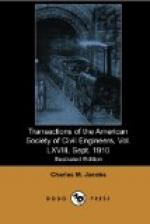The New York Tunnel Extension is essentially a passenger line, although the Company has not only the legal powers but also the facilities for making it a through route for freight if desired. It will transport passengers to and from the centrally located station at 33d Street and Seventh Avenue in New York City, joining the Long Island System at Sunnyside Yard, and, by means of the New York Connecting Railroad, it will form a link in the through traffic line, connecting the whole Pennsylvania System with the New England States. This line has been designed for the safe and expeditious handling of a large volume of traffic. The requirements include handling the heaviest through express trains south and west from the main line as well as the frequent and lighter local-service trains. For through service the locomotive principle of operation has been adhered to, that is, electric locomotives will take up the work of the steam locomotives at the interchange yard at Harrison, N. J., and, for excursion and suburban service to nearby towns, provision will be made for electric locomotives, or by operation of special self-propelled motor cars in trains, the project being planned to give the greatest flexibility in method of operation to meet the growing demand in the best way.
The New York Connecting Railroad has important functions both for freight and passenger service. When constructed it will be about 12 miles long, and will form a part of the line to the New England States for through passenger and freight service, and also carry local freight to and from Sunnyside Yard and Brooklyn, and all points on Long Island. By means of this line it will be possible to make the Brooklyn station at Flatbush Avenue a station on the through System for New England as well as the Western States.
[Illustration: FIG. 1. (Full page image)
MAP OF THE PENNSYLVANIA R. R. CO’S NEW YORK
TUNNEL EXTENSION AND
CONNECTIONS.]
The initial equipment of the Western Division of the Long Island Railroad for electric traction has been made in advance of the opening of the tunnel line in order to take care of the requirements of the Atlantic Avenue improvement. This improvement involved the elimination of grade crossings within the City of Brooklyn and the conversion of the railroad line which was previously on the surface of the streets to part subway and part elevated line from the Flatbush Avenue Terminal to East New York Station, a distance of 5-1/4 miles. One of the requirements of this improvement was that the motive power should be changed to some form of power not involving combustion. This led to the adoption of electricity, and, in order to meet operating necessities, involved the electrification of connecting lines beyond the improvement proper, so that local service could be handled to the end of the runs without changing the motive power. The extent of the electrification thus required was found to be about 100 single-track miles. This




